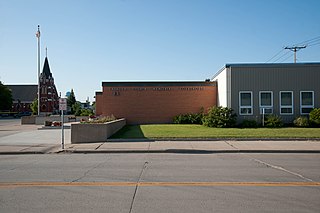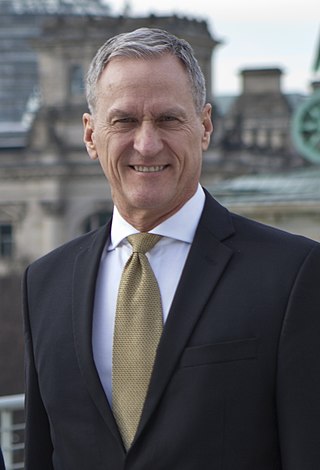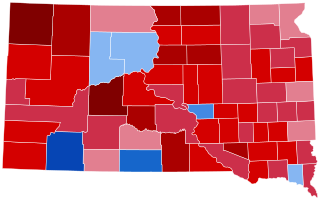Related Research Articles

South Dakota is a U.S. state in the North Central region of the United States. It is also part of the Great Plains. South Dakota is named after the Dakota Sioux tribe,which comprises a large portion of the population with nine reservations currently in the state and has historically dominated the territory. South Dakota is the 17th largest by area,but the 5th least populous,and the 5th least densely populated of the 50 United States. Pierre is the state capital,and Sioux Falls,with a population of about 213,900,is South Dakota's most populous city. The state is bisected by the Missouri River,dividing South Dakota into two geographically and socially distinct halves,known to residents as "East River" and "West River". South Dakota is bordered by the states of North Dakota,Minnesota,Iowa,Nebraska,Wyoming,and Montana.

The 1936 United States presidential election was the 38th quadrennial presidential election,held on Tuesday,November 3,1936. In the midst of the Great Depression,incumbent Democratic President Franklin D. Roosevelt defeated Republican Governor Alf Landon of Kansas. Roosevelt won the highest share of the popular vote (60.3%) and the electoral vote since the largely uncontested 1820 election. The sweeping victory consolidated the New Deal Coalition in control of the Fifth Party System.

Cavalier County is a county in the U.S. state of North Dakota. It is south of the Canada–US border with Manitoba. As of the 2020 census,the population was 3,704. Its county seat is Langdon. The city of Cavalier is in nearby Pembina County.

Dakota County is the third-most populous county in the U.S. state of Minnesota,located in the east central portion of the state. As of the 2020 census,the population was 439,882. The population of Dakota County was estimated to be 443,341 in 2022. The county seat is Hastings. Dakota County is named for the Dakota Sioux tribal bands who inhabited the area.

Brookings is a city in Brookings County,South Dakota,United States. Brookings is South Dakota's fourth most populous city,with a population of 23,377 at the 2020 census. It is the county seat of Brookings County,and home to South Dakota State University,the state's largest institution of higher education. Also in Brookings are the South Dakota Art Museum,the Children's Museum of South Dakota,the annual Brookings Summer Arts Festival,and the headquarters of several manufacturing companies and agricultural operations.

Yankton is a city in and the county seat of Yankton County,South Dakota,United States.

William Frederick Lemke was an American politician who represented North Dakota in the United States House of Representatives as a member of the Republican Party. He was also the Union Party's presidential candidate in the 1936 presidential election.

William John Bulow was an American politician and lawyer. He was the first Democratic Governor of South Dakota,serving from 1927 to 1931. He received the highest number of votes of any Democratic candidate for governor in the state up to that time. Bulow then went on to serve as a member of the United States Senate from South Dakota from 1931 to 1943.

The South Dakota Supreme Court is the highest court in the state of South Dakota. It is composed of a chief justice and four associate justices appointed by the governor. One justice is selected from each of five geographic appointment districts. Justices face a nonpolitical retention election three years after appointment and every eight years after that. The justices also select their own chief justice.

William Henry McMaster was an American politician who served as the tenth Governor of South Dakota from 1921 until 1925. A member of the Republican Party,he went on to serve as a member of the United States Senate from South Dakota from 1925 to 1931.

William Williamson was an American teacher,a lawyer,a and judge who served as a U.S. Representative from South Dakota from 1921 to 1933. He was the last U.S. Representative from the third district of South Dakota.

William Henry Parker was an American attorney,South Dakota politician,and American Civil War veteran. Parker served as an Assistant United States Attorney for the District of Colorado and was a member of the United States House of Representatives from South Dakota.

Dennis Martin Daugaard is an American attorney and politician who served as the 32nd governor of South Dakota from 2011 to 2019. A member of the Republican Party,he was the first chief executive of a U.S. state to be the child of deaf parents. Before being elected governor,he was a lawyer,banker,development director for a nonprofit organization;he also served as a state senator from 1997 to 2003 and the 37th lieutenant governor of South Dakota from 2003 to 2011.

Frank Leroy Farrar was an American politician who was the 24th governor of South Dakota. A Republican from Britton,he served as the state's attorney general from 1963 to 1969,and as governor from 1969 to 1971. After leaving office,he chaired several holding companies and became the owner of numerous banks.

Bartlett Tripp was a diplomat,Chief Justice of the Dakota Territory Supreme Court,first professor of the University of South Dakota College of Law and first President of the South Dakota Bar Association.

Sioux Kingsbury Grigsby was an attorney and politician in the United States state of South Dakota. Grigsby was born into a prominent pioneering family,Kingsbury family in South Dakota and set up a law practice which he would maintain for over 60 years. Grigsby served as state representative,state senator,and Lieutenant Governor of South Dakota from 1945 to 1949.

The 2020 United States presidential election in South Dakota was held on Tuesday,November 3,2020,as part of the 2020 United States presidential election in which all 50 states plus the District of Columbia participated. South Dakota voters chose electors to represent them in the Electoral College via a popular vote,pitting the Republican Party's nominee,incumbent President Donald Trump,and running mate Vice President Mike Pence against Democratic Party nominee,former Vice President Joe Biden,and his running mate California Senator Kamala Harris. South Dakota has three electoral votes in the Electoral College.

The 1920 South Dakota gubernatorial election was held on November 2,1920. Incumbent Republican Governor Peter Norbeck declined to run for re-election,instead choosing to run for the U.S. Senate. Lieutenant Governor William H. McMaster won the Republican primary and advanced to the general election,where he faced Nonpartisan League candidate Mark P. Bates and former State Senator William W. Howes,the Democratic nominee. The election was largely a replay of the 1918 election,with McMaster winning a large victory,Bates coming in second,and Howes coming in a distant third.

The 1924 South Dakota gubernatorial election was held on November 4,1924. Incumbent Republican Governor William H. McMaster declined to run for re-election to a third term,instead opting to run for the U.S. Senate. Lieutenant Governor Carl Gunderson won the Republican primary unopposed. In the general election,he faced three prominent opponents:Democratic nominee William J. Bulow,a former State Senator and Mayor of Beresford;Farmer–Labor nominee A. L. Putnam;and perennial candidate Richard O. Richards. Gunderson. With the left-leaning vote split,Gunderson won the election in a landslide.
References
- ↑ "SDLRC - William J. Shorma". Sdlegislature.gov. Retrieved 19 July 2018.
- ↑ "Senator William Shorma". South Dakota Legislature. Retrieved September 21, 2016.